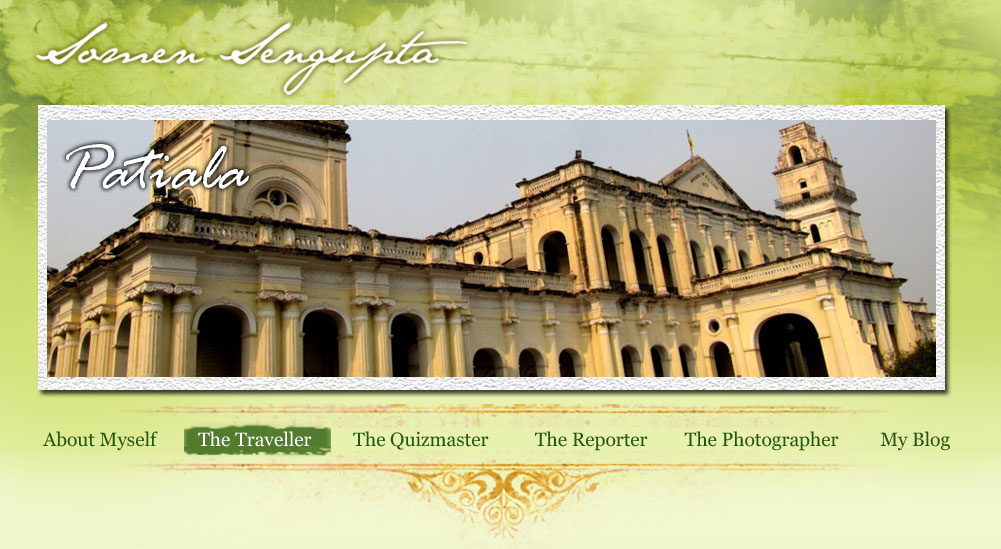| Patiala : The royal herald of Punjabi pride. |
|
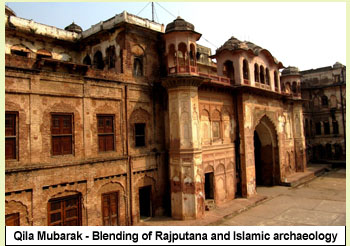 Ever since Mughal administrative control started collapsing over the vast kingdom left by Aurangazeb in 1707, many province across the country started declaring independence and rulers of those places started behaving like independent ruler.
It was the time regional power started over taking Delhi and centralized rule deceased in India till the time it was reestablished by British East India Company in mid of 19th century. In south it was Nizam while in west and east it was Maraths and Murshidqali Khan of Bengal-Bihar-Orissa who became almost as independent as Mughal. Ever since Mughal administrative control started collapsing over the vast kingdom left by Aurangazeb in 1707, many province across the country started declaring independence and rulers of those places started behaving like independent ruler.
It was the time regional power started over taking Delhi and centralized rule deceased in India till the time it was reestablished by British East India Company in mid of 19th century. In south it was Nizam while in west and east it was Maraths and Murshidqali Khan of Bengal-Bihar-Orissa who became almost as independent as Mughal.
Near to Delhi, in north the biggest landmass demarked by it’s language and culture was Punjab. Soon Punjab gone out of control of Delhi and it all started from a small place named Patiala.
For a commoner Patiala is famous for it’s large whisky peg, designer shoes and classical school of music. A lover of sports may add little more by saying it as the home of Sports Authority of India country’s national sports training centre. However that is only a little to know the rich & pristine past of Patiala the town. It is here the Sikh tasted their first independence from Islamic rulers and it is here where the light of knowledge sparked in modern time.
It all started from 1714 with a brave man named Baba Ala Singh whose father Chowdhury Ram Singh was blessed by Sikh Guru Govind Singh. By taking advantage of his position Ala Singh converted 30 small villages into an independent kingdom after fighting many gory battles with Afgan, Marathas and Mughal. A cunning politician who cared little for ethics Ala Singh did all that would protect his people and kingdom.In 3rd battle of Panipath he joined as a partner of Ahmed Shah Abdali while also doing food grain supply to Maratha. However by any mean he founded a kingdom of his own out of nothing. After him he successors with their sheer hard work and military skill finally shaped the kingdom totally independent from any outside rulers even from Ranjit Singh the legendary warrior king of Punjab. With a treaty in 1809 with Lord Minto of East India Company Patiala ensured it’s British protection from Sultej river to Yamuna river. It was enough to end Ranjit’s dream to take over Patiala. As a mark of long lasting friendship Patiala openly supported British in suppressing great Indian mutiny of 1857.
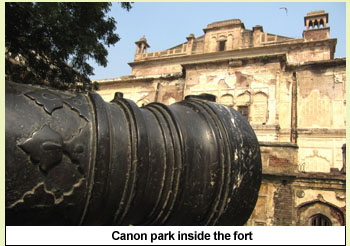 The city of Patiala in 19th century was the main political hub of a kingdom running from Shivalik in north to border of Rajasthan. The city of Patiala in 19th century was the main political hub of a kingdom running from Shivalik in north to border of Rajasthan.
After the defeat of Marathas in 3rd battle of Panipath in 1761, entire Punjab was under threat of Afgani looters and it was the time city of Patiala got it’s first significant architecture in the name of qila Mubarak.
Initially built as a mud fort the structure was later set up by Baba Ala Singh in 1763 from the revenue collected from the traders passing Grand Trunk Road. This gives a royal recognition to Patiala as an independent state & after many years of non-stop struggle against Mughal. Afgans and Maratha it finally got it’s place in history. In 1809 Royal family of Patiala even entered into a treaty to help British against of Maharaja Ranjit Singh the biggest icon of Punjab and that was the beginning of long friendship with British that lasted till 1947 when Maharaja of Patiala came forward as first princely state to sign Indian Government’s instrument of accession. It made Patiala state merged with Indian state of Punjab along with many other district of eastern Punjab. Maharaja Bhupindar Singh from 1900 to 1939 for both good and bad reasons made Patiala famous. His ardent love for cricket, polo, gems, automobiles, music and finest women of the world ( not to mention his more than 80 children from various legitimate and illegitimate queens ) made Patiala famous all over the globe as one of the most extra ordinary Indian native state under British Union Jack. After independence Patiala was the first Indian province to accept accession offer of Indian Govt and king of Patiala was honored as chancellor of Chamber of Princes.
Till today fort Qila Mubarak is the main archaeological attraction of Patiala town.The fort stands at the mid of city centre.
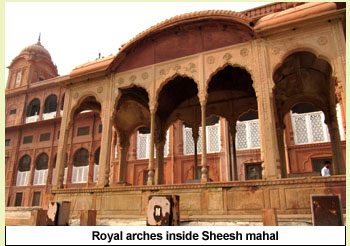 The old part of the fort made by Baba Ala Khan is known as Qila Andaroon while the new modern part was done by Karam Singh where most of the buildings are standing now.The royal arched gate takes visitor inside of a massive courtyard which is surrounded with magnificent palaces built in the blending of Islamic and Rajput school of architecture. The pillar, carnies, arches, chatri, jharokha, jali and royal gates all constructed between 18th century to mid of 20th century till the time royal family shifted to a new palace Moti Bagh give an outstanding testimony of peaceful co-existence of two different kind of archaeological school. The long flight of stairs goes to the durbar hall built by Karam Singh now a museum. Though the museum is poorly illuminated and not kept in the best of it’s form it’s artifacts are treasure to feel the regal life of that time. Arms and ammunition along with royal attires of the time with plethora of old photograph throws light on a bygone era. Massive collection of coins, domestic artifacts, oil paintings & old horse carriages are the main attraction of the durbal hall museum. The biggest eye catcher of the museum is a sword of Nadir Shah the Iranian invaders who looted and vandalized India in 1739. A rich collection of Kangra and Rajasthani paintings are also to be checked. Though the museum is not equipped with any physical or audio guide a little attention of self help will benefit the visitor for sure. The old part of the fort made by Baba Ala Khan is known as Qila Andaroon while the new modern part was done by Karam Singh where most of the buildings are standing now.The royal arched gate takes visitor inside of a massive courtyard which is surrounded with magnificent palaces built in the blending of Islamic and Rajput school of architecture. The pillar, carnies, arches, chatri, jharokha, jali and royal gates all constructed between 18th century to mid of 20th century till the time royal family shifted to a new palace Moti Bagh give an outstanding testimony of peaceful co-existence of two different kind of archaeological school. The long flight of stairs goes to the durbar hall built by Karam Singh now a museum. Though the museum is poorly illuminated and not kept in the best of it’s form it’s artifacts are treasure to feel the regal life of that time. Arms and ammunition along with royal attires of the time with plethora of old photograph throws light on a bygone era. Massive collection of coins, domestic artifacts, oil paintings & old horse carriages are the main attraction of the durbal hall museum. The biggest eye catcher of the museum is a sword of Nadir Shah the Iranian invaders who looted and vandalized India in 1739. A rich collection of Kangra and Rajasthani paintings are also to be checked. Though the museum is not equipped with any physical or audio guide a little attention of self help will benefit the visitor for sure.
The canon park of the fort is another gem. Experience the military supremacy of Patiala by visiting this small yard where huge iron canons from different times are in display.
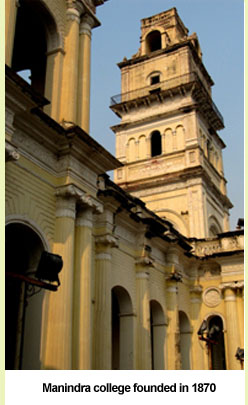 Moti Bagh palace built by Narendra Singh in 1847 where royal family later on shifted is another gem of archeological blending. It ‘s garden was once compared with Shalimar bagh of Kashmir. Counted as one of the finest palace of Punjab this palace is now dedicated to nation since 1961 in form of housing Sports Authority of India’s head office. Moti Bagh palace built by Narendra Singh in 1847 where royal family later on shifted is another gem of archeological blending. It ‘s garden was once compared with Shalimar bagh of Kashmir. Counted as one of the finest palace of Punjab this palace is now dedicated to nation since 1961 in form of housing Sports Authority of India’s head office.
Named as Netaji Subhash National Institute of Sports since 1973, it houses an excellent sports museum that preserves Dhyanchand’s historical gold medal of Amsterdam Olympics and medal won by PT Usha in 1986 Seoul Asian Games along with many rare articles and photographs. It also has collection of Milkha Singh’s Adidas boot used in 1960’s Rome Olympics and a bat signed by all members of Indian cricket team that won 1983 cricket world cup. The rich heritage of polo and cricket of Patiala is very nicely displayed. Various sports collection of Maharaja Bhupindar Singh who was the member of Indian cricket team that travelled to England is here in display. This is an unique museum of India.
Seesh Mahal meaning the glass house is another feast of eyes as far as it’s archaeology is concerned. The palace has a heritage hanging bridge inside of it’s ground. The bridge hangs over decorative pillars. The palace houses a museum that has rich collection of miniature kangra paintings. The full series of Radhakrishna leela inspired from Jayadeva’s Geeta Govinda. Apart from that it has world’s largest collection of medals and decoration donated by various kings. 3200 medals are on display covering almost all great honors of the world except a Nobel for example.
Bahadurgargh forst built by Karam Singh has memories of Guru Teg Bhadur who had visited the palace as it is believed.
We will derive a wrong impression of Patila if we recognize it only as a seat of regal glamour.
If regality is the first identity of Patialia then it’s contribution in wisdom and culture can also be counted equally high. The oldest educational institute of Punjab came here in Patiala when Mahindra college was opened in 1870. Later on expanded when on 17th March 1884 viceroy of India Marquess of Ripon did the honor of opening a new building .It’s foundation stone was laid by another viceroy Lord Northbrook in 1875. Founded with full support and funding from 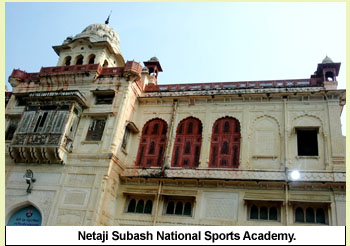 royal family and British Government it started functioning under University of Calcutta and first chaired by Bengali educationist Jogindranath Mukherjee. In that era this college has no match from Lahore to Delhi. It was the oldest college, older even than University of Lahore. The college building is a marvelous piece of Indo-European architecture that stands like a royal monument on it’s 21 acre campus one of the biggest college campus in India. The central tower and pillars that support library and other buildings are testimony of how special care was taken to make it a real place of sophisticated scholarship. royal family and British Government it started functioning under University of Calcutta and first chaired by Bengali educationist Jogindranath Mukherjee. In that era this college has no match from Lahore to Delhi. It was the oldest college, older even than University of Lahore. The college building is a marvelous piece of Indo-European architecture that stands like a royal monument on it’s 21 acre campus one of the biggest college campus in India. The central tower and pillars that support library and other buildings are testimony of how special care was taken to make it a real place of sophisticated scholarship.
The story of Patila will remain incomplete if the music of Patiala is not metioned. The kingdom took a birth as a result of weak Mughal administration and with that a new school of music was also born for the same reason. With it’s decline many top musicians left Mughal durbar of Delhi and gradually migrated to Patiala. With them came a new wave of culture that created an amazing gharana which produced legend of Indian classical music like Ustad Bade Gulam Ali Khan, Akhtar Hussain, Bindu Khan and many more. Patiala gharana is now counted one of the elite stream of Indian Hindustani classical music.
It is not only a rich history that makes Patiala special.It is an unique blending of music, education, sports, food and a regal touch that takes the city to the highest herald of Punjabi pride which is almost synonymous with Indian pride to an outsider.
This article was published in The Hitavada on 23rd October 2016
Click here to view the original article
|
